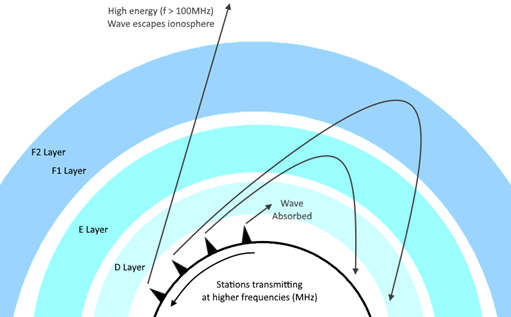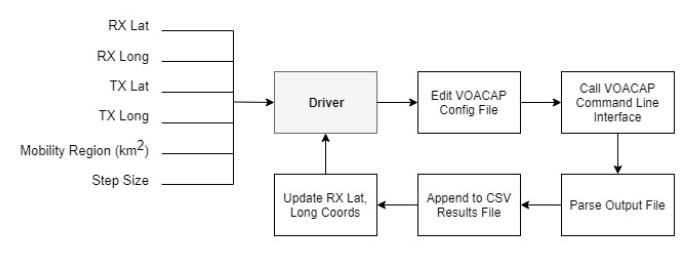Projects:2018s1-102 HF Radio Automated Link Establishment (ALE) Model
Contents
Project Team
Students
Surbhi Ahuja
Sandul Fernando
Blake Luetkens
Supervisors
Prof. Lang White
Paul Hirschausen
2G ALE Radio Network Simulator
Introduction
The industry sponsor for this project, Codan - Radio Communications Division, referenced as Codan from this point, are a supplier of HF radio communication solutions to customers types such as hobbyists, humanitarian organisations and Australian military operations. HF communication enables communication between a transmitter and receiver unit by taking advantage of HF wave propagation characteristics, particularly the wave reflection with ionised layers in the ionosphere to enable over the horizon communication - this is called skywave propagation.
The 2018 group undertaking this project name will be continuing the work done on a 2G-ALE simulator that was delivered by a 2017 group under the same project name and sponsor. Our group aims to incorporate ionospheric prediction data and transmitting radio mobility into the 2G ALE simulator to provide Codan with quality of service statistics and indicators regarding achievable connection links and channel requirements.
The wiki of the 2017 group can be found here at 2017 HF Radio Automated Link Establishment (ALE) Model.
Background
HF radio is still actively used and protocols (such as the new 4G ALE) that use HF communication continue to be actively developed. HF radio communication is critical for use in geographic locations without established communication infrastructure that are occupied by military personal or being aided by humanitarian groups. Protocols such as ALE ensure that no expert training is required for the operation of HF radios or knowledge of ionospheric conditions or effects on HF wave propagation.
The ionosphere is a layer of the atmosphere that contains electrically charged (ionised) particles and is located 60km - 1000km above the Earths surface. The ionosphere can be separated into multiple layers, each classified by density of these ionised particle, each layer has a different effect on wave energy absorption and reflection. The state of the ionosphere plays a key role in the propagation of HF waves. The ionisation in the ionosphere varies greatly depending on various factors such as the time of day, season, sun spot numbers and space weather conditions. All effect the ionospheric properties and the perversity of particular layers. For example the D layer at the ionosphere is typically no longer present during night time, and the F layer is distinct enough that is can be considered at 2 different layers, F1 and F2. The higher the frequency of a wave, the higher it's penetration capabilities through the ionosphere and thus the further it can travel in the ionosphere before it is reflected. Lower frequency waves are often attenuated heavily or absorbed completely in the lower layers. Higher energy waves that can travel through these layers and reflect off the higher F layers result in the highest propagation distances. It is possible that the energy is high enough in the wave such that the wave escapes the ionosphere, or low enough such that the wave is completely absorbed in the ionosphere. These 2 extremes outline the wide range of reflection possibilities.
As discussed the ionosphere effects the available reflection paths between radio stations, another key component to the path available is the geographical location and distance between these 2 stations. Relative ionospheric effects vary depending on location on the Earths surface, and the distance between two stations in part define the number of available paths available between two stations for known frequencies and ionospheric effects. Figure 1 shows potential HF wave communication paths as a function of distance.
- Figure 1
Aims
The aims for each section in terms of project deliverables to Codan Radio Communications Division are itemised below.
Simulator with Ionospheric Prediction Data
- Incorporate ionospheric prediction data and provided SNR<->linking probability map into simulator.
- Output quality of service statistics at any point within a mobility region.
- Linking probabilities.
- Number of channels required to guarantee a particular level of service.
- Develop an efficient algorithm to minimise prediction software calls and simulation time while ensuring accurate results.
- Verify optimised results against complete data and full simulation runs and compare results and execution time.
- Visually represent linking probability within a known mobility region per available frequency and time of year.
Impedance Switching using a Re-purposed ATU
- Develop microcontroller code with functions capable of turning on specified relays that switch in reactances
- Confirm switched in reactances per enabled relay
- Create program on host computer that can switch on relays via a TTL - RS232 COM port connection
Markov Chains
Ionospheric Prediction Data
Ionospheric Prediction Software
Several ionospheric prediction software tools were considered for use in this project.
It was ultimately decided that the group would proceed with VOACAP due to it's more developed command line and configuration file functionality.
VOACAP Parser
To extract data from VOACAP in an efficent way, a parser was developed in C++. This parser accepted the transmitter and receiver coordinates, a mobility region and desired step size and generated hourly, and monthly SNR statistics. A diagram explaining the input and process of the parser program is shown in Figure 2.
- Figure 2
Due to the relatively small coverage area that we will be considering, and the inherent inaccuracy already present in prediction tools, it was agreed upon to use flat earth equations to determine latitude and longitude coordinates.
Graphing SNR
Due to the dependence SNR would have on the linking probability and channel requirements, and based on the project requirement to visually represent the linking probability in terms of a mobility region. The group decided at this stage to determine the approach to graphing the data.
Matlab offers a C++ API that enables calls to be made from within the same central C++ codebase, it also was fast enough to manage millions of lines of data.
Our parsed data from VOACAP can be conceptually split into the following structure.
Month
Hour
Mobility Region
(Changing RX Lat, RX Long coordinates)
Frequency and SNR pairs
Thus the result is (# of Frequencies * 24 Hours * # of Months) graphs. To obfuscate the amount of graphs and to ensure that the data was displayed in a clearly understandable way visually the group decided to use animated heatmaps that would cycle through the hours of the day, updating the contents as it cycled.
An example of a generated heatmap that demonstrates the coverage area as the receiver moves away from the transmitter. The starting point of both stations is the center of Figure 3.
- Figure 3
Simulating Mobility
Optimisation Concerns
TBC
Results
TBC
Conclusion
STAGE 2
Developing a Regression Testing System
Introduction
A mini project (stage 2) which is independent to the 2G-ALE simulator was also introduced to the group this year. Stage 2 of this project is to use an existing impedance matching box to develop a regression testing system which allows automatic selection of impedances and other parameters (Voltage, Temperature) for regression testing for Codan’s systems. There are a number of inductors & capacitors inside the impedance matching box which are all connected to relays. The microcontroller code controls what the relays are and the positioning of the relays. Aim of stage 2 is to rewrite the microcontroller code to give direct access to the impedance elements (minimum requirement). In addition, it would be ideal to develop a full regression testing system which incorporates various other test equipment (Power supply, Temperature Chamber Control).
Background Information
3040 Automatic Whip Antenna
The Automatic Whip Antenna is designed to provide continuous tuning for antennas that scan multiple frequencies. The 3040 is designed for full compatibility with all modes of operation including receiver scanning, Automatic Link Establishment (ALE) and data. When tuning, the antenna seeks the optimum tuning point, ensuring the best communications possible are achieved. The 3040 Whip Antenna has a 125W power handling capability which is used for voice and data operations over the full 2 – 30 MHz frequency band (HF range). This is built to resist severe conditions that are often experienced in HF radio deployments. Inside the Whip Antenna, there are a number of inductors and capacitors which are connected to relays. Relays are switches that open and close circuits electromechanically or electronically. The microcontroller inside the unit controls what the relays are and the positioning of the relays.
Impedance Matching
In antenna tuning units, impedance matching networks are designed for radio antenna transmission systems. These systems transmit maximum power to the antenna in order to achieve maximum transmission efficiency. Typically, the antenna impedance is a complex function of the antenna placement, frequency operation and environmental factors. Therefore, the impedance matching network must be an adjustable one, with acceptable matching capacity. This impedance matching process is performed by controlling the network parameters adaptively.
Microcontroller Programming
The microcontroller that will be reprogrammed is the ATMEGA64-16AU. It is a high-performing, low-power Atmel AVR® 8-bit microcontroller. During this project, the reprogramming of the microcontroller will be done in ATMEL Studio 7. It is an Integrated Development Environment (IDE) which is used to develop and debug all AVR® microcontrollers. Atmel studio provides an easy to use environment to write, build and debug applications written in C/C++ or assembly code. For this project, the code will be written in C. Attached below is the pin configuration of the ATMEGA64.
Each digital I/O port of the microcontroller is associated with three registers.
Data Direction Register (DDRx) DDRx is an 8-bit register. It stores configuration information for the pins of Portx. (i.e: Pin numbers 35-42 in Figure 2 are the 8 pins in port C) To make a specific pin an input, a ‘1’ can be written to the required pin location in the DDRx Similarly, to make a specific pin an output pin, a ‘0’ can be written.
PINx–Port X Input Pins Register - PINx is an 8-bit register. Stores the logic value and the current state of the pins. Values on the pins of Portx can be read by its PIN register.
PORTx – Port X data register - PORTx is an 8-bit register. Stores the logic values currently being outputted on the pins of Portx.
Emulator
During stage two, JTAGICE3 will be used for emulating. JTAGEICE3 is an on-chip emulator which is used for emulating and programming of AVR® ATMEGA microcontrollers. It runs the code written in ATMEL Studio on the microcontroller in real time. This gives the user complete access to the internal resources of the microcontroller and to control the execution in the device.




